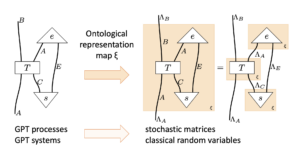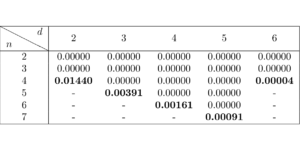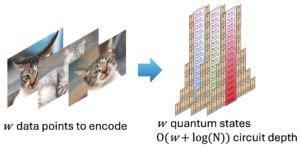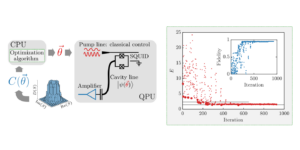Riverlane, Cambridge, UK
Find this paper interesting or want to discuss? Scite or leave a comment on SciRate.
Abstract
Rapidly improving gate fidelities for coherent operations mean that errors in state preparation and measurement (SPAM) may become a dominant source of error for fault-tolerant operation of quantum computers. This is particularly acute in superconducting systems, where tradeoffs in measurement fidelity and qubit lifetimes have limited overall performance. Fortunately, the essentially classical nature of preparation and measurement enables a wide variety of techniques for improving quality using auxiliary qubits combined with classical control and post-selection. In practice, however, post-selection greatly complicates the scheduling of processes such as syndrome extraction. Here we present a family of quantum circuits that prepare high-quality |0$rangle$ states without post-selection, instead using CNOT and Toffoli gates to non-linearly permute the computational basis. We find meaningful performance enhancements when two-qubit gate fidelities errors go below 0.2%, and even better performance when native Toffoli gates are available.
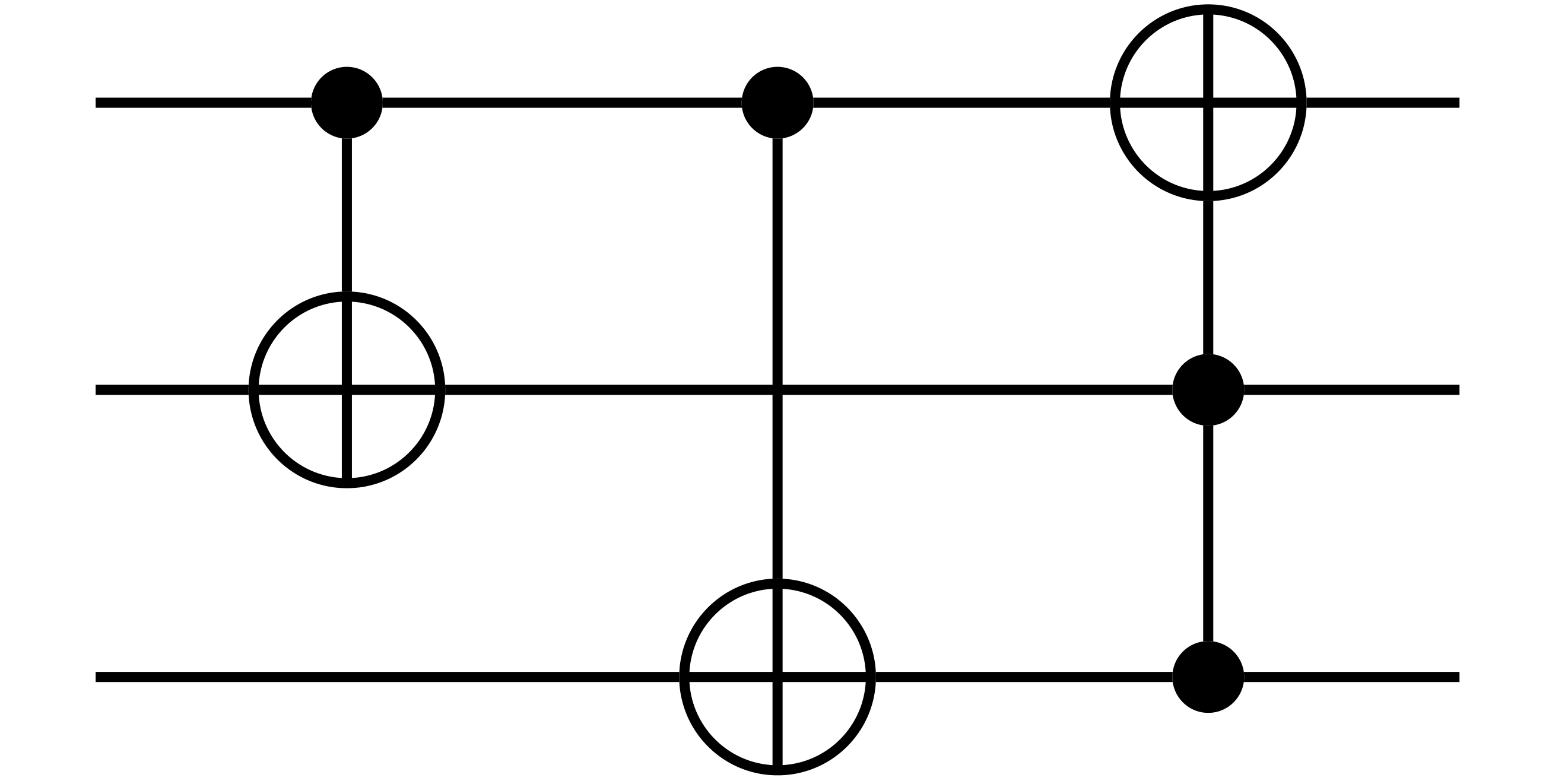
► BibTeX data
► References
[1] Frank Arute, Kunal Arya, Ryan Babbush, Dave Bacon, Joseph C. Bardin, Rami Barends, Rupak Biswas, Sergio Boixo, Fernando G. S. L. Brandao, David A. Buell, et al. Quantum supremacy using a programmable superconducting processor. Nature, 574 (7779): 505–510, 2019. 10.1038/s41586-019-1666-5.
https://doi.org/10.1038/s41586-019-1666-5
[2] Jacob Z. Blumoff, Andrew S. Pan, Tyler E. Keating, Reed W. Andrews, David W. Barnes, Teresa L. Brecht, Edward T. Croke, Larken E. Euliss, Jacob A. Fast, Clayton A. C. Jackson, Aaron M. Jones, Joseph Kerckhoff, Robert K. Lanza, Kate Raach, Bryan J. Thomas, Roland Velunta, Aaron J. Weinstein, Thaddeus D. Ladd, Kevin Eng, Matthew G. Borselli, Andrew T. Hunter, and Matthew T. Rakher. Fast and high-fidelity state preparation and measurement in triple-quantum-dot spin qubits. PRX Quantum, 3: 010352, Mar 2022. 10.1103/PRXQuantum.3.010352. URL https://doi.org/10.1103/PRXQuantum.3.010352.
https://doi.org/10.1103/PRXQuantum.3.010352
[3] P. Oscar Boykin, Tal Mor, Vwani Roychowdhury, Farrokh Vatan, and Rutger Vrijen. Algorithmic cooling and scalable NMR quantum computers. Proceedings of the National Academy of Sciences, 99 (6): 3388–3393, 2002. 10.1073/pnas.241641898.
https://doi.org/10.1073/pnas.241641898
[4] Gilles Brassard, Yuval Elias, Tal Mor, and Yossi Weinstein. Prospects and limitations of algorithmic cooling. The European Physical Journal Plus, 129 (11): 1–16, 2014. 10.1140/epjp/i2014-14258-0.
https://doi.org/10.1140/epjp/i2014-14258-0
[5] S. M. Brewer, J.-S. Chen, A. M. Hankin, E. R. Clements, C. W. Chou, D. J. Wineland, D. B. Hume, and D. R. Leibrandt. $^{27}$Al$^{+}$ quantum-logic clock with a systematic uncertainty below ${10}^{{-}18}$. Phys. Rev. Lett., 123: 033201, Jul 2019. 10.1103/PhysRevLett.123.033201. URL https://doi.org/10.1103/PhysRevLett.123.033201.
https://doi.org/10.1103/PhysRevLett.123.033201
[6] Benjamin Desef. Yquant: Typesetting quantum circuits in a human-readable language. 2020. 10.48550/ARXIV.2007.12931. URL https://arxiv.org/abs/2007.12931. arXiv:2007.12931.
https://doi.org/10.48550/ARXIV.2007.12931
arXiv:2007.12931
[7] John D. Dixon and Brian Mortimer. Permutation groups. Springer, New York, NY, 1996. 10.1007/978-1-4612-0731-3.
https://doi.org/10.1007/978-1-4612-0731-3
[8] Salvatore S. Elder, Christopher S. Wang, Philip Reinhold, Connor T. Hann, Kevin S. Chou, Brian J. Lester, Serge Rosenblum, Luigi Frunzio, Liang Jiang, and Robert J. Schoelkopf. High-fidelity measurement of qubits encoded in multilevel superconducting circuits. Phys. Rev. X, 10: 011001, Jan 2020. 10.1103/PhysRevX.10.011001. URL https://doi.org/10.1103/PhysRevX.10.011001.
https://doi.org/10.1103/PhysRevX.10.011001
[9] Yuval Elias, Tal Mor, and Yossi Weinstein. Semioptimal practicable algorithmic cooling. Phys. Rev. A, 83: 042340, Apr 2011. 10.1103/PhysRevA.83.042340. URL https://doi.org/10.1103/PhysRevA.83.042340.
https://doi.org/10.1103/PhysRevA.83.042340
[10] Alexander Erhard, Joel J. Wallman, Lukas Postler, Michael Meth, Roman Stricker, Esteban A. Martinez, Philipp Schindler, Thomas Monz, Joseph Emerson, and Rainer Blatt. Characterizing large-scale quantum computers via cycle benchmarking. Nature Communications, 10 (1): 1–7, 2019. 10.1038/s41467-019-13068-7.
https://doi.org/10.1038/s41467-019-13068-7
[11] José M. Fernandez, Seth Lloyd, Tal Mor, and Vwani Roychowdhury. Algorithmic cooling of spins: A practicable method for increasing polarization. International Journal of Quantum Information, 02 (04): 461–477, 2004. 10.1142/S0219749904000419. URL https://doi.org/10.1142/S0219749904000419.
https://doi.org/10.1142/S0219749904000419
[12] David Gajewski. Analysis of Groups Generated by Quantum Gates. PhD thesis, University of Toledo, 2009.
[13] Michael R. Geller and Mingyu Sun. Toward efficient correction of multiqubit measurement errors: pair correlation method. Quantum Science and Technology, 6 (2): 025009, Feb 2021. 10.1088/2058-9565/abd5c9. URL https://doi.org/10.1088/2058-9565/abd5c9.
https://doi.org/10.1088/2058-9565/abd5c9
[14] Rebecca Hicks, Bryce Kobrin, Christian W. Bauer, and Benjamin Nachman. Active readout-error mitigation. Phys. Rev. A, 105: 012419, Jan 2022. 10.1103/PhysRevA.105.012419. URL https://doi.org/10.1103/PhysRevA.105.012419.
https://doi.org/10.1103/PhysRevA.105.012419
[15] D. B. Hume, T. Rosenband, and D. J. Wineland. High-fidelity adaptive qubit detection through repetitive quantum nondemolition measurements. Phys. Rev. Lett., 99: 120502, Sep 2007. 10.1103/PhysRevLett.99.120502. URL https://doi.org/10.1103/PhysRevLett.99.120502.
https://doi.org/10.1103/PhysRevLett.99.120502
[16] IBM. Rising above the noise: Quantum-limited amplifiers empower the readout of IBM quantum systems. IBM Research Blog, Jan 2020. URL https://www.ibm.com/blogs/research/2020/01/quantum-limited-amplifiers/. https://www.ibm.com/blogs/research/2020/01/quantum-limited-amplifiers/.
https://www.ibm.com/blogs/research/2020/01/quantum-limited-amplifiers/
[17] L. Jiang, J. S. Hodges, J. R. Maze, P. Maurer, J. M. Taylor, D. G. Cory, P. R. Hemmer, R. L. Walsworth, A. Yacoby, A. S. Zibrov, and M. D. Lukin. Repetitive readout of a single electronic spin via quantum logic with nuclear spin ancillae. Science, 326 (5950): 267–272, 2009. 10.1126/science.1176496. URL https://www.science.org/doi/abs/10.1126/science.1176496.
https://doi.org/10.1126/science.1176496
[18] Raymond Laflamme, Junan Lin, and Tal Mor. Algorithmic cooling for resolving state preparation and measurement errors in quantum computing. Physical Review A, 106 (1): 012439, 2022. 10.1103/PhysRevA.106.012439.
https://doi.org/10.1103/PhysRevA.106.012439
[19] Ilya N. Moskalenko, Ilya A. Simakov, Nikolay N. Abramov, Alexander A. Grigorev, Dmitry O. Moskalev, Anastasiya A. Pishchimova, Nikita S. Smirnov, Evgeniy V. Zikiy, Ilya A. Rodionov, and Ilya S. Besedin. High fidelity two-qubit gates on fluxoniums using a tunable coupler. npj Quantum Information, 8 (1): 130, 2022. 10.1038/s41534-022-00644-x.
https://doi.org/10.1038/s41534-022-00644-x
[20] A. Opremcak, C. H. Liu, C. Wilen, K. Okubo, B. G. Christensen, D. Sank, T. C. White, A. Vainsencher, M. Giustina, A. Megrant, B. Burkett, B. L. T. Plourde, and R. McDermott. High-fidelity measurement of a superconducting qubit using an on-chip microwave photon counter. Phys. Rev. X, 11: 011027, Feb 2021. 10.1103/PhysRevX.11.011027. URL https://doi.org/10.1103/PhysRevX.11.011027.
https://doi.org/10.1103/PhysRevX.11.011027
[21] Riverlane. Source code and data behind this paper. Github, Aug 2022. URL https://github.com/riverlane/purification-without-post-selection. https://github.com/riverlane/purification-without-post-selection.
https://github.com/riverlane/purification-without-post-selection
[22] Leonard J. Schulman and Umesh V. Vazirani. Molecular scale heat engines and scalable quantum computation. In Proceedings of the Thirty-First Annual ACM Symposium on Theory of Computing, STOC ’99, page 322–329, New York, NY, USA, 1999. Association for Computing Machinery. ISBN 1581130678. 10.1145/301250.301332. URL https://doi.org/10.1145/301250.301332.
https://doi.org/10.1145/301250.301332
[23] Youngkyu Sung, Leon Ding, Jochen Braumüller, Antti Vepsäläinen, Bharath Kannan, Morten Kjaergaard, Ami Greene, Gabriel O. Samach, Chris McNally, David Kim, Alexander Melville, Bethany M. Niedzielski, Mollie E. Schwartz, Jonilyn L. Yoder, Terry P. Orlando, Simon Gustavsson, and William D. Oliver. Realization of high-fidelity CZ and ZZ-free iSWAP gates with a tunable coupler. Phys. Rev. X, 11: 021058, Jun 2021. 10.1103/PhysRevX.11.021058. URL https://doi.org/10.1103/PhysRevX.11.021058.
https://doi.org/10.1103/PhysRevX.11.021058
[24] Yasunari Suzuki, Suguru Endo, Keisuke Fujii, and Yuuki Tokunaga. Quantum error mitigation as a universal error reduction technique: Applications from the NISQ to the fault-tolerant quantum computing eras. PRX Quantum, 3: 010345, Mar 2022. 10.1103/PRXQuantum.3.010345. URL https://doi.org/10.1103/PRXQuantum.3.010345.
https://doi.org/10.1103/PRXQuantum.3.010345
[25] Kristan Temme, Sergey Bravyi, and Jay M. Gambetta. Error mitigation for short-depth quantum circuits. Phys. Rev. Lett., 119: 180509, Nov 2017. 10.1103/PhysRevLett.119.180509. URL https://doi.org/10.1103/PhysRevLett.119.180509.
https://doi.org/10.1103/PhysRevLett.119.180509
[26] Ye Wang, Stephen Crain, Chao Fang, Bichen Zhang, Shilin Huang, Qiyao Liang, Pak Hong Leung, Kenneth R. Brown, and Jungsang Kim. High-fidelity two-qubit gates using a microelectromechanical-system-based beam steering system for individual qubit addressing. Phys. Rev. Lett., 125: 150505, Oct 2020. 10.1103/PhysRevLett.125.150505. URL https://doi.org/10.1103/PhysRevLett.125.150505.
https://doi.org/10.1103/PhysRevLett.125.150505
[27] Kenneth Wright, Kristin M. Beck, Sea Debnath, J. M. Amini, Y. Nam, N. Grzesiak, J.-S. Chen, N. C. Pisenti, M. Chmielewski, C. Collins, et al. Benchmarking an 11-qubit quantum computer. Nature Communications, 10 (1): 1–6, 2019. 10.1038/s41467-019-13534-2.
https://doi.org/10.1038/s41467-019-13534-2
[28] Wenchao Xu, Aditya V. Venkatramani, Sergio H. Cantú, Tamara Šumarac, Valentin Klüsener, Mikhail D. Lukin, and Vladan Vuletić. Fast preparation and detection of a Rydberg qubit using atomic ensembles. Phys. Rev. Lett., 127: 050501, Jul 2021. 10.1103/PhysRevLett.127.050501. URL https://doi.org/10.1103/PhysRevLett.127.050501.
https://doi.org/10.1103/PhysRevLett.127.050501
Cited by
[1] Adam Kinos and Klaus Mølmer, “Optical multiqubit gate operations on an excitation-blockaded atomic quantum register”, Physical Review Research 5 1, 013205 (2023).
The above citations are from SAO/NASA ADS (last updated successfully 2023-05-06 00:27:38). The list may be incomplete as not all publishers provide suitable and complete citation data.
On Crossref’s cited-by service no data on citing works was found (last attempt 2023-05-06 00:27:36).
This Paper is published in Quantum under the Creative Commons Attribution 4.0 International (CC BY 4.0) license. Copyright remains with the original copyright holders such as the authors or their institutions.
- SEO Powered Content & PR Distribution. Get Amplified Today.
- PlatoAiStream. Web3 Data Intelligence. Knowledge Amplified. Access Here.
- Minting the Future w Adryenn Ashley. Access Here.
- Buy and Sell Shares in PRE-IPO Companies with PREIPO®. Access Here.
- Source: https://quantum-journal.org/papers/q-2023-05-04-994/
- :is
- :not
- :where
- ][p
- 1
- 10
- 11
- 12
- 13
- 14
- 15%
- 1996
- 1999
- 2%
- 20
- 2011
- 2014
- 2017
- 2019
- 2020
- 2021
- 2022
- 2023
- 22
- 23
- 24
- 26%
- 27
- 28
- 7
- 8
- 9
- a
- Aaron
- above
- ABSTRACT
- Academy
- access
- ACM
- active
- Adam
- addressing
- affiliations
- AL
- Alexander
- algorithmic
- All
- an
- analysis
- and
- Andrew
- annual
- applications
- apr
- ARE
- AS
- Association
- Aug
- author
- authors
- available
- basis
- BE
- Beam
- become
- behind
- below
- ben
- benchmarking
- Benjamin
- Better
- Blog
- Break
- Brian
- Bryan
- by
- cambridge
- chen
- Chris
- Christensen
- Christopher
- Clock
- code
- COHERENT
- combined
- comment
- Commons
- Communications
- complete
- computation
- computer
- computers
- computing
- control
- copyright
- Correlation
- Counter
- crain
- cycle
- CZ
- data
- Dave
- David
- Detection
- discuss
- dominant
- e
- E&T
- Edward
- efficient
- elder
- Electronic
- empower
- enables
- Engines
- enhancements
- error
- Errors
- essentially
- European
- Even
- family
- FAST
- Feb
- fidelity
- Find
- For
- Fortunately
- found
- from
- Gates
- generated
- Gilles
- GitHub
- Go
- greatly
- Group’s
- harvard
- Have
- here
- High
- high-quality
- holders
- Hong
- However
- HTTPS
- human-readable
- Hume
- i
- IBM
- ibm quantum
- improving
- in
- increasing
- individual
- information
- instead
- institutions
- interesting
- International
- Jackson
- Jan
- JavaScript
- John
- journal
- Kim
- language
- large-scale
- Last
- Leave
- License
- limitations
- Limited
- List
- logic
- machinery
- matthew
- max-width
- May..
- mean
- meaningful
- measurement
- measurements
- method
- Michael
- mitigation
- molecular
- Month
- Nam
- National
- native
- Nature
- New
- New York
- no
- Noise
- nuclear
- NY
- Oct
- of
- on
- open
- operation
- Operations
- or
- original
- Orlando
- overall
- page
- Paper
- particularly
- performance
- physical
- plato
- Plato Data Intelligence
- PlatoData
- plus
- practice
- Prepare
- present
- Proceedings
- processes
- Processor
- prospects
- provide
- published
- publisher
- publishers
- quality
- Quantum
- Quantum Computer
- quantum computers
- quantum computing
- quantum information
- Quantum Supremacy
- quantum systems
- Qubit
- qubits
- RAMI
- realization
- reduction
- references
- register
- remains
- repetitive
- research
- resolving
- review
- rising
- Riverlane
- ROBERT
- Roland
- Ryan
- s
- scalable
- Scale
- scheduling
- Science
- Science and Technology
- SCIENCES
- SEA
- Simon
- single
- Source
- source code
- spam
- Spin
- spin qubits
- spins
- State
- States
- Stephen
- Successfully
- such
- suitable
- Sun
- superconducting
- Symposium
- system
- Systems
- tamara
- techniques
- Technology
- that
- The
- their
- thesis
- this
- Through
- Title
- to
- toward
- Uncertainty
- under
- Universal
- university
- updated
- URL
- USA
- using
- variety
- via
- volume
- W
- want
- was
- we
- when
- white
- wide
- with
- without
- works
- Wright
- X
- Ye
- year
- york
- zephyrnet



